Window Feeder Open The ‘window’ To Better Bream Fishing.
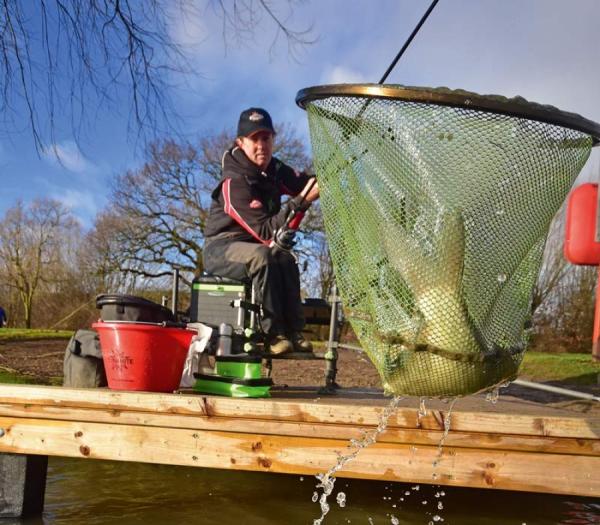
When fishing at long range for big slabs, Dynamite Baits’ Ian Smith reckons the window feeder is a tactic that takes some beating…
With ‘traditional’ feeders you used to have the choice of either a blockend (maggot) feeder or an open-ended one. These days there sits in the middle what is known as a window feeder.
These are more a hybrid of the two. Having started their existence in Ireland, in the last few years they have become more and more popular in this country. The reason being they are brilliant for use when fishing at long distances.
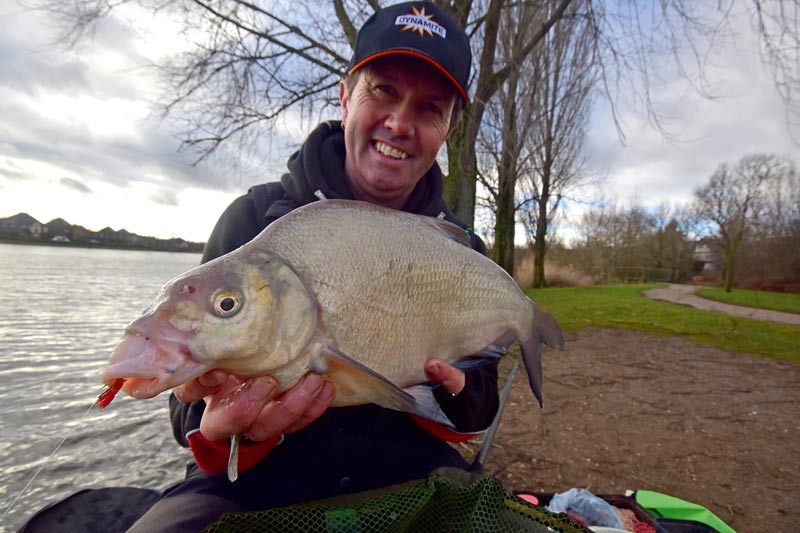
Also, having a window in the side of the body of the feeder means they are ideally suited to feeding a payload of almost wholly particles with only a tiny amount of groundbait, which is used to seal the feeder. Experience over the years has demonstrated that at this time of year, fish – and especially the larger ones – prefer to graze over particles, such as pellets, rather than groundbait.
To reveal just how good window feeders can be, comparative to their cousins the blockend, open-ended and cage feeders, I spent the day targeting Milton Keynes’ Furzton Lake’s bream population, using a combination of Dynamite Baits’ new F1 pellets, liquid and groundbait.
The Advantages Of The Window Feeder
All feeders are devices made to deliver a payload of loose feed into your chosen swim. The window feeder brings with it a number of distinct advantages over other makes and models.
The first plus point is their shape. Having a long, elongated body, with the casting weight moulded into the base, they are a feeder designed primarily for fishing accurately at extreme distances as they travel through the air like a bullet and I can quite easily cast them 70 yards; up to 90 if the wind is favourable.
Regarding the payload of the feeder, a blockend (maggot) feeder will work well in flowing water, but is not so good in stillwaters. Plus, the payload needs to be ideally live maggots that can wriggle their way out of the feeder’s holes.
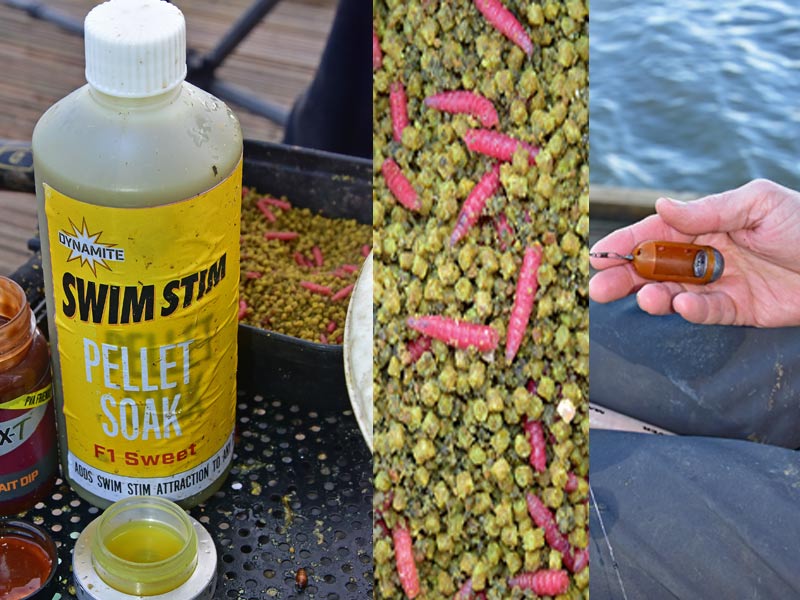
Compared to the open-ended feeder, yes you can load these with any loose feed you want, but to seal them correctly you will need to plug the ends with groundbait, meaning that around 40 per cent of the payload will be crumb rather than particles. As I said earlier, this is not something that tends to work that well at this time of year. The window feeder only needs around 10 per cent groundbait, just to ‘seal’ the window itself.
Furthermore, with the window feeder you can alter the amount of pressure you load the loose feed with, so regardless of the depth, the feeder will always get to the bottom before dispensing any of the payload.
Once the groundbait breaks down, the payload is free to pour out without the need to move the feeder as you’d need to do with an open-ended version. To help the payload empty more efficiently, I tend to place a few live maggots in the feeder first, before topping it up with a mixture of dead reds and Dynamite Baits’ Swim Stim F1 pellets. The live maggots help to push the rest of the payload out, creating the perfect bait presentation.
Bait Choices
The live maggots are used straight from the tackle shop; my dead maggots, however, are treated very differently.
To ensure they remain plump and juicy I place the live grubs in a bag before taking out all of the air and sealing it. The maggots are then placed in the fridge for two days prior to freezing. I also like to riddle off the maize, replacing it with a little Dynamite Red Krill groundbait. As the maggots defrost I find they take on the smell of the krill, which really helps boost their appeal.
For my pellets, I again prepare them prior to the session. The night before, I place the required amount in a bait tub and then ‘just’ cover them in water. I then leave them overnight to fully absorb all the liquid. I dislike soaking and pouring off any excess water as I feel you are throwing away a lot of the attraction and flavour that has leached out of the pellets into the soaking water.
In the morning, the pellets will be perfectly prepared.
Over the past couple of months, I have been enjoying a lot of success employing the new F1 pellets. I think their combination of fish and sweet is really appealing to bream and skimmers as well as F1s. They are a really versatile pellet I find, ideal for my type of fishing.
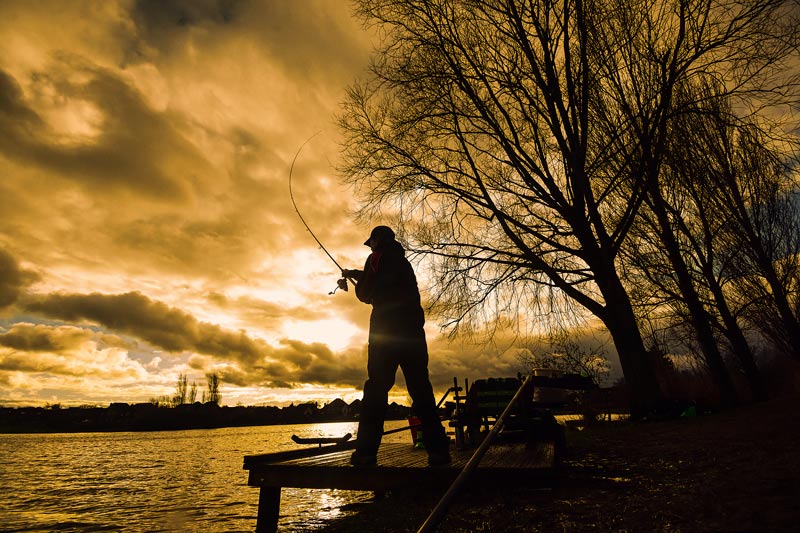
Regarding the matching Pellet Soak liquid, I don’t add this to the F1 pellets, but I will use it if I’m using fishery-only pellets, as it makes them almost as good as the actual F1 pellets.
The final part of my baiting strategy is the groundbait, used to seal the particles in the feeder. To complement the F1 pellets and because I have a huge amount of faith and confidence in the flavour, I use a mixture of the new Swim Stim F1 groundbait, combined 50/50 with Swim Stim Amino Black. I like to add the Black at this time of year because as well as boosting the groundbait’s fishmeal content, it helps to dull down the colour of the F1, which is quite a bright burnished gold colour, something that is ideal in the coloured water of summer but a bit much when the water is still relatively clear.
To work effectively with the window feeder, the groundbait needs to be mixed on the damp side, so it seals the feeder until it gets to the lake bed.
How To Load The Window Feeder
1: Start by placing a few live maggots in the feeder
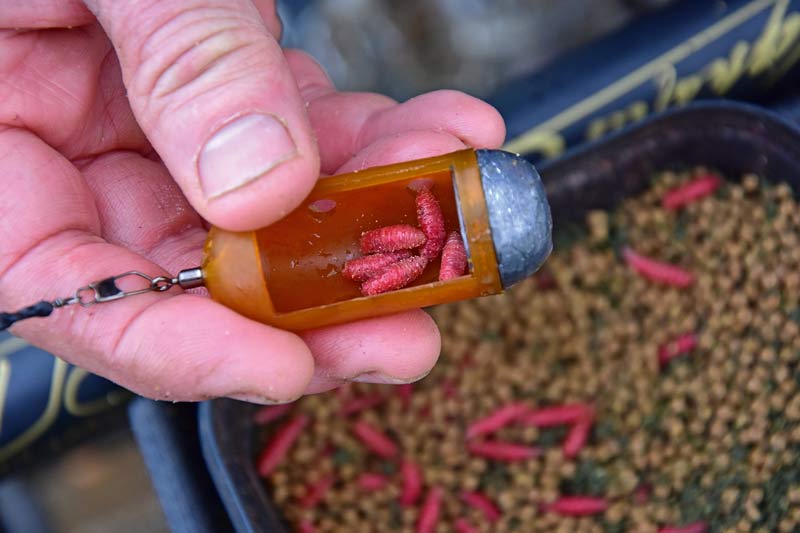
2: Next, wholly fill the chamber with a mixture of F1 pellets and dead reds
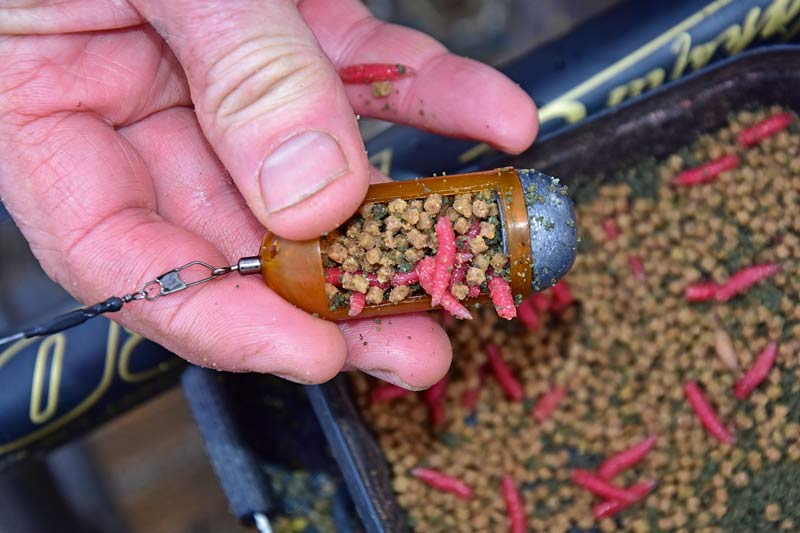
3 Cap off the loaded feeder with a smear of groundbait and press it down firmly.
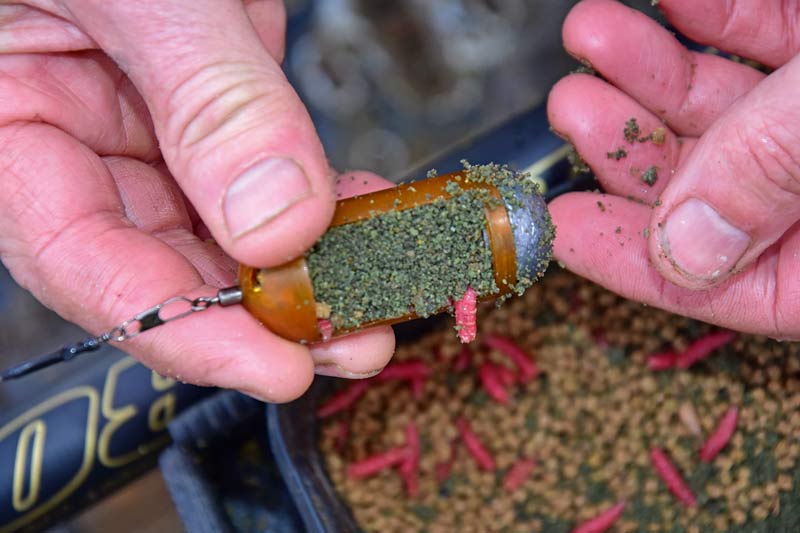
Going The Distance
Furzton Lake, like a lot of bream venues, is quite an expanse of water, so distance casting is the name of the game.
I match my 12ft 8in Maver Diamond feeder rod with a Long Cast reel, which I have loaded with 0.08mm braid. I use braid, not for its higher breaking strain relative to diameter, but being much thinner and having almost zero stretch, it is perfect for long-distance casting.
The zero stretch means a mono shockleader is essential; not only does it help take the ‘sting’ out of the cast, it also helps protect my fingers when giving it ‘the big one’! I use two rod lengths (around 25 feet) of 10lb mono for the leader.
The feeder is mounted free-running and is trapped on the leader by a float stop, below which I form a 6in length of twisted line. This acts as a boom, ensuring tangles are kept to an absolute minimum.
To start the session, I will kick off with a large feeder, dropping down to either a medium or small version as the session progresses.
As for the hook link, again I choose a ‘hybrid’ length of two feet. This is longer than the more ‘new school’ anglers fish, but not quite as long as the traditionalists like to use. I find two feet is about right to ensure the hook bait is far enough away from the feeder, but close enough to still show very positive bites.
A size 18 Pellet Waggler hook completes the setup, which is tied with a hair-rigged bait band, into which I mount three maggots. This offers the fish a decent-sized target bait, but one that is not too big. Also, being hair-rigged, I find I get much better hook-holds, something that is essential when you’re playing a large bream to the bank from well over 70 yards!
I will also boost my maggot hook bait by dipping them into either a little Complex-T hook bait dip or the new F1 Pellet Soak liquid.
And, by just using maggots on the hook, it forces the bream into a ‘take it or leave it’ feeding scenario. If I had loose fed a range of different baits, that’s when you have to constantly swap your hook baits to see what the bream want through the session. With my approach, they have no choice!
Starting the session more frugally than I would in the summer, I tend to recast my large feeder every four to five minutes for the first 30 minutes to get a bed of bait down. In the summer, I’d feed a load of bait at the start to draw and hold the shoal. As it’s still early in the year, less is more.
After this initial hit, I slow the casting down to every 10 minutes or so. I always carry a stopwatch to better time my casts too.
Bream fishing is a balancing act between feeding enough to draw and keep them, but not casting too often that you end up spooking them either.
If you follow these few basic rules that I have laid out, you should be enjoying good sport, with the minimum of effort every time you visit the bank.
By swapping the kind of feeder you are using, you’ll soon find yourself opening the ‘window’ to the bream session of your dreams.
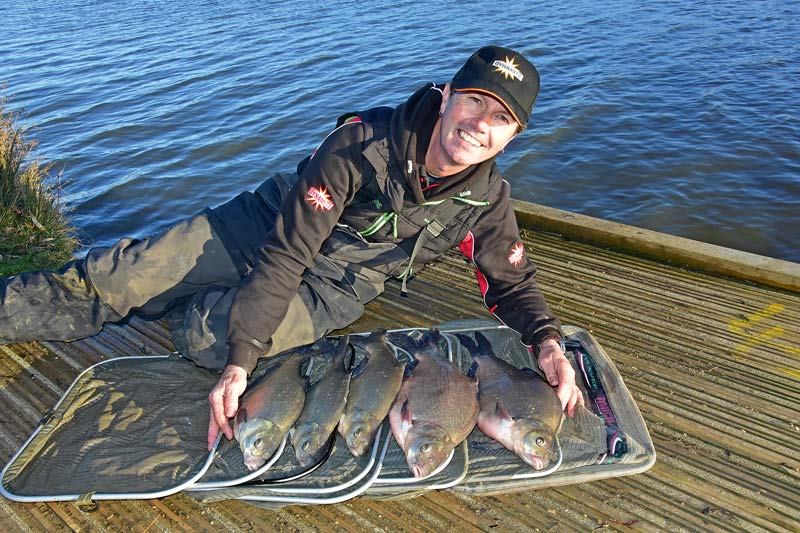
Words: Ian Smith. Pictures: Mark Parker
Angler Profile
Ian Smith
Age: 51
Based: Bedford
Sponsors: Dynamite Baits
FOR MORE GREAT FEATURES
- Log in or register to post comments














